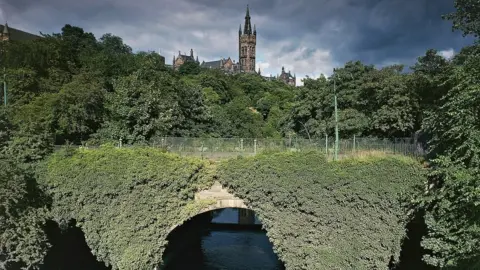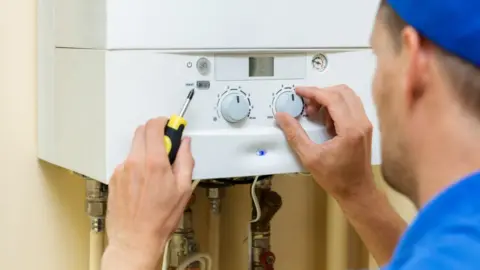How Scotland's parks could heat homes with low-carbon energy
 Getty Images
Getty ImagesScotland's parks could provide low-carbon energy to heat 15% of the country's homes, according to new research.
A study of 3,500 green spaces suggested urban parks could be used to generate significant amounts of energy by capturing the heat in the ground.
This could then be fed out to heat neighbouring homes.
Decarbonising the heat network is a challenge for the Scottish government as most homes have gas boilers.
When burned, the gas releases large amounts of carbon dioxide which stays in the atmosphere and contributes towards climate change.
 Getty Images
Getty ImagesHow can parks produce energy?
Greenspace Scotland says ground-source heat pumps in urban parks could save vast amounts of carbon by replacing fossil-fuel heating systems.
The report, called ParkPower, suggests that the pumps would be buried more than 1m (3ft) under football pitches or recreational grass land.
It involves laying horizontal coils which extract heat from the soil which is, in turn, heated by the sun, making it renewable.
The longer the coil, the more heat can be extracted meaning significant numbers of homes can be kept warm through district heating.
A scheme at Saughton Public Park in Edinburgh has been used as a pilot but only to heat buildings within the park.
 Pete McDougall, City of Edinburgh Council
Pete McDougall, City of Edinburgh CouncilJulie Procter, chief executive of Greenspace Scotland, said: "We are all familiar with thinking about Scotland's parks as our natural health service, our children's outdoor classrooms and our cities' green lungs.
"The findings of the ParkPower project mean we could soon add 'community power stations' to that list."
Reaching 'net-zero'
Residential emissions, mostly from heating, accounted for 14.9% of Scotland's total greenhouse gas emissions in 2017.
Although that was a fall in real terms, it was mainly attributed to mild weather meaning people were heating their homes less often.
Decarbonising the heat network will require gas boilers to be replaced in most homes if Scotland's target to reduce emissions to "net-zero" by 2045 is met.
A much more efficient alternative is district heating where hot water is generated at a small local power station and then piped into homes to be used in taps and radiators.
Even a gas-fired district heating system is more efficient that individual boilers but heating the water from a renewable source, such as ground-source heat pumps, would be much better.
The ParkPower report also suggests that these systems could make parks profitable for councils or community owners.
The research was carried out by energy and and engineering consultants Ramboll.
UK district energy manager Paul Steen said: "A key challenge in meeting Scotland's net-zero carbon ambition by 2045 is decarbonising our energy system. The ParkPower project shows the huge green-energy potential waiting to be unlocked."
The Scottish government has a target to generate 11% of non-electrical heat from low carbon sources by 2020.
Greenspace Scotland says that is unlikely to be met with the most recent estimates suggesting that only 6% has been achieved so far.
